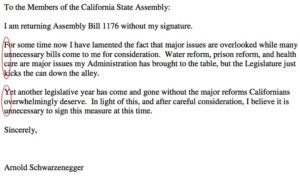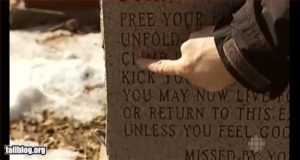The biggest cipher news of the week (apart from learning that David Hamer’s splendid M4 4-rotor Kreigsmarine Enigma s/n M7772 is to be sold by Sotheby’s New York on 12th December 2017) is a sad story concerning Dalek operator (and Whovian columnist ‘The Watcher’) Nicholas Pegg (not to be confused with perennial voice-of-the-Daleks Nicholas Briggs) and hidden writing.
“What are these words? Explain! Explain!“
Though quickly picked up by the Telegraph and others, it was Twitter user Dave Elliott whose tweet contained the image of the offending page in Doctor Who magazine:
As you can see from the string of highlighted letters above, the hidden message says simply: “Panini and BBC Worldwide are cunts”. Unsurprisingly, Pegg has had his contract (ex)terminated, and will no doubt find himself on the next shuttle to the Dalek Asylum planet, where the BBC puts all its dissidents.
Order of the Boot
Another recent BBC leaver was James May, who also has a hidden message story. As features editor on magazine Autocar, he once inserted the following (fairly innocent) message one letter at a time into the headers of the (riveting-sounding) 1992 Autocar Special Road Test Yearbook Issue.
“So you think it’s really good, yeah? You should try making the bloody thing up. It’s a real pain in the arse.”
For his sterling efforts, May quickly received the Order of the Boot (or Order of the Trunk, as Americans like to call it).
Bungled Fond Farewell
Another less obvious departure letter was by Mark Dunning, the headmaster of Orley Farm prep school in Harrow, as summed up (fairly glibly, it has to be said) by Matthew Norman in the Telegraph.
Dunning, in an end of term newsletter, wrote (of the departing teacher Roger Clark): “We all now know every really great teacher has to finish one day and Mr Clark will do so at the end of this term”, i.e.
We
All
Now
Know
Every
Really
(etc)
When Clark raised this with the school governors, they took a dim cryptanalytical view of the affair, and requested that Dunning should also depart. Oh well.
Incidentally, a separate Telegraph piece noted that “[f]ormer pupils of the school include Anthony Horowitz, the novelist, who has been critical of his “unbelievably brutal” time there in the 1960s.”
Historically, though, Dunning’s arguably-less-than-completely-fond farewell was dwarfed by the 1949 poem (thanks to Mental Floss) composed on the occasion of Gordon Macdonald (the last Governor of Newfoundland), and printed in the Newfoundland Evening Telegram two days after his departure:
The prayers of countless thousands sent
Heavenwards to speed thy safe return,
Ennobled as thou art with duty well performed,
Bringing peace, security and joy
Among the peoples of this New Found Land.
So saddened and depressed until your presence
Taught us discern and help decide what’s best for
All on whom fortune had not smiled.
Remember if you will the kindness and the love
Devotion and the respect that we the people have for Thee
“Farewell!”
Political Steganography
More recently, the American political class – largely enraged by Trump’s extensive rhetoric against them – has carried out all manner of political steganography. There’s RESIST (added by the seventeen members of Donald Trump’s arts council) that Klaus posted about earlier this year, and IMPEACH (science envoy Daniel Kammen’s parting shot), following Trump’s response to a white nationalist rally in Charlottesville VA).
But in many ways, these are mere ghostly wraiths: for as far as political steganography goes, the real deal is none other than Arnold Schwarzenegger, affectionately referred to by TechCrunch as the “Governator”. His 2009 letter vetoing Assembly Bill 1176 stands as a classic of the genre:
According to the Huffington Post:
“My goodness. What a coincidence,” said Schwarzenegger spokesman Aaron McLear. “I suppose when you do so many vetoes, something like this is bound to happen.”
Which, of course, triggered a near-googolplex of mathematical posts calculating the (dwindlingly small) probability, leading to the whole affair being included in Princeton University’s stats lecture notes (Hint: to do this properly, you’d need word-initial letter distribution statistics, rather than =POWER(1/26, 7) )
You may also remember this (c.f. Troy McClure) from the famous Montreal gravestone:
…which also brings to mind the fake gravestone laid by PETA in ‘tribute’ to Harland Sanders…
Tasty. :-/
Protest Steganography
Finally: there’s one further category of steganography, where writers conceal anti-government messages in their writings. Of course, poets have concealed messages in poems for centuries (if not millennia), but here I’m talking about something quite on the next level.
Jose F. Lacaba wrote a poem called “Prometheus Unbound” that was published in an entirely mainstream publication: when people in the government realised that the initial letters spelled out the phrase “MARCOS HITLER! DIKTADOR TUTA!” (a common rally chant widely graffitied in the 1970s) that Lacaba was jailed for being a dissident. (He was only let out when the same regime tried to give an award to “golden boy” Nick Joaquin: Joaquin would only accept it in return for Lacaba’s freedom.)
When I found the actual poem here, it was a pleasing coincidence that its final word is RESIST:
Mars shall glow tonight,
Artemis is out of sight.
Rust in the twilight sky
Colors a bloodshot eye,
Or shall I say that dust
Sunders the sleep of just?Hold fast to the gift of fire!
I am rage! I am wrath! I am ire!
The vulture sits on my rock,
Licks at the chains that mock
Emancipation’s breath,
Reeks of death, death, death.Death shall not unclench me.
I am earth, wind and sea!
Kisses bestow on the brave
That defy the damp of grave
And strike the chill hand of
Death with the flaming sword of love.Orion stirs. The vulture
Retreats from the hard, pure
Thrust of the spark that burns,
Unbounds, departs, returns
To pluck out of death’s fist
A god who dared to resist.






Hi Nick,
Another example of protest steganography is the Polish-language poem “Runą” (“They will fall”). It was written by a teacher named Zbigniew Turek in 1939 in Soviet-occupied Lviv, but for many years attributed in the popular mind to the Nobel-winning poet Czeslaw Milosz. The poem passed the occupying forces’ censors (!) and was printed in their Polish-language propaganda newspaper, the “Red Banner” (!!).
The poem is in four verses, which were printed in two columns. Read conventionally top-down then left to right it reads like a typically kitsch paen to Stalin (“Oh bright Sun, leader Stalin, May your fame never die”). Read left to right ignoring the columns it criticizes Stalin and predicts his fall and hails Poland (“May your fame never die … Poland, and your daughters and sons”).
Unfortunately I couldn’t find anything in English about it. Here is a link to a post in Polish with a photo of the poem and of an article explaining its history:
http://polimaty.pl/2013/04/nie-milosz-wykiwal-cenzure/
According to the article Turek also wrote some acrostic protest poems like your examples, but these never achieved the same fame,
Simple, brilliant – acrostic key. Wow.
Greg: thanks, a great example of the art I wasn’t previously aware of. 🙂
Nick, Do you know if anyone has ever tested whether the columns of separated initial letters/glyphs (say on f.49v) might be acrostics?
If it were, could the plain text be retrieved, do you think?
Diane: if the left column on Voynich Manuscript f49v contained acrostics, it would just be a column of text. However, analysing it as a column of text does not yield anything useful: and trying to work with it as a piece of normal Voynichese text yields a number of difficulties, such as how its two “2” shapes fit into the bigger picture.
There is also a 4o with a curved overbar over the o on one of f49v’s lines: this could be read as implying that this page may well have been one of the earliest pages to have been written.
Nick
Thanks.
re overbar. It’s an Intriguing thought. If it is one you explained in ‘Curse’ I can’t read it at the moment . On hols. Would you mind outlining the argument?
A possible topic for investigation: How is it possible that the edit distance between any post on ciphermysteries and the Voynich MS is one? That is, judging by how quickly the V appears in every comments thread…. Maybe it’s a strange attractor?
Thanks Nick Pelling for the Dalek article. It reminds me much of the beginning chapters of Simon Sign’s book “The Codebook” on modern reasons of examples where codes when intercepted by the wrong person (or here, maybe personalities .. LOL ) can lead to unwanted consequences. Stronger coding to remove the ‘Alice’ in the middle only removes ‘Alice’ from the beginning source of revelation. Access (a publically distributed document magazine, etc…) creates more difficulty in keeping the code out of sight. Go figure …. LOL
Thanks again for sharing and providing the amusing enjoyment this morning !
Ling buzz (a preprint site for linguistic papers) has an article in Science Survey by a certain Gerard Cheshire alleging a decipherment of the manuscript, here: http://ling.auf.net/lingbuzz/003737
He claims it is written in proto-Romance but the deciphered text does not look like it to me.
Stephen: I have a copy of Cheshire’s draft paper and will be discussing it shortly. Note that the rather grand-sounding “Science Survey” isn’t actually a journal per se, but something he has dreamed up to dress his paper nicely. Which is OK, but perhaps a little baroque for my tastes.
Thanks. I await to hear what you have to say about it.
I emailed Mr Cheshire before and he expressed some doubts as to whether he is correct or not after all. But I will need to look at his article.
One thing I have noticed with this and other translations/decipherments is that the deciphered text still seems somewhat cryptic and so hard to read or understand. It also seems to lack informational content, so that one does not feel that one has learnt any more about the Voynich or author from reading it or provided any testable information. I like to believe that the text of the Voynich says lots of interesting things which shed light on the drawings not that it is largely superfluous given the amount of effort applied to encipherment.
However this does not mean that Mr Cheshire or anyone else’s translation is not correct. I will need to look closer at his paper.
Mark: I would advise waiting for the Cipher Mysteries review of Cheshire’s draft before investing a great deal of your time…
Nick: Certainly. I will await your analysis.